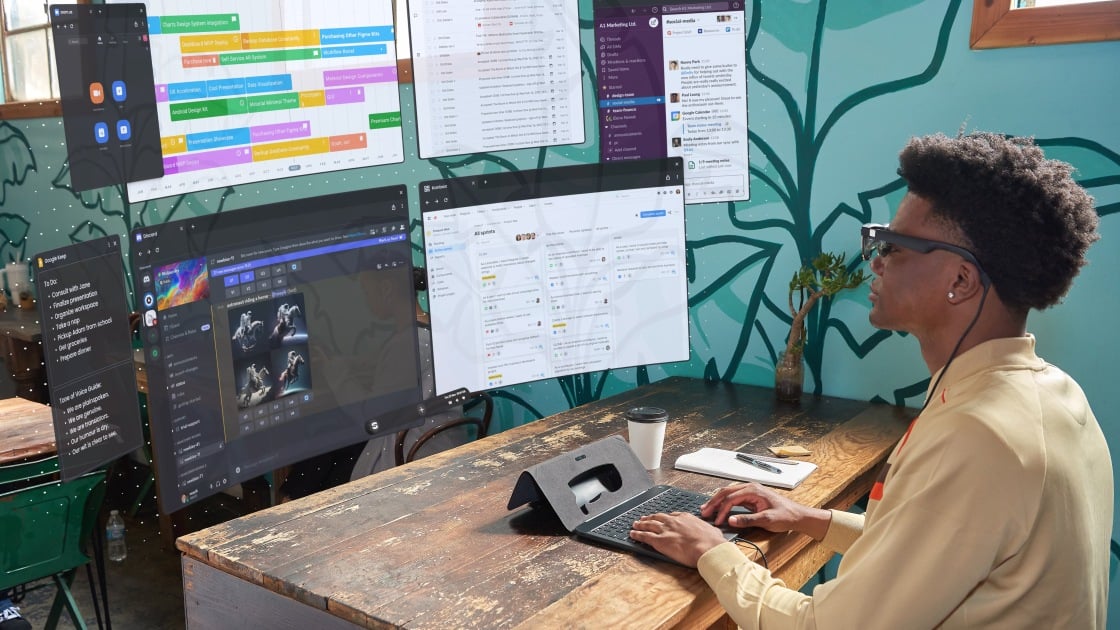
A laptop that ditches the screen for augmented reality glasses can soon be yours for $1,900. Israeli startup Sightful is now accepting preorders for the Spacetop G1, which will ship to US customers in October.The Spacetop beams a 100-inch virtual screen to your eyes. We tried an early access version last year. At the time, it was only available via invites so the 60-person Sightful team could gather feedback before a formal launch. According to Sightful CEO Tamir Berliner, that input led to major improvements to the original model. “We made Gen 1 the best productivity tool anyone can imagine,” he said in an interview.
(Credit: PCMag/Michael Kan)
The productivity gains come from the huge screen real estate Spacetop users get while donning the PC’s AR glasses. No longer confined to a 13- or 17-inch screen, users can play around on a virtual screen that reaches 100 inches across and extends all around your field of view. “It feels like we’ve already surpassed workstation-level productivity,” Berliner says. “If you look at three [physical] screens versus what you get with Spacetop now, we beat three screens. We’re able to give you a better ability to manage your space.”Last week, PCMag had about 10 minutes to try the Spacetop G1, and it does seem like the product has been refined across the board. When I put on the glasses, I noticed that the image quality was brighter and sharper than the early access model, making the windows and icons appear clearer. I also had access to four browser windows spread across the screen space.
(Credit: PCMag/Michael Kan)
Regarding specs, the glasses use two OLED panels, each with a 1,920-by-1,080 resolution and a refresh rate of up to 90Hz. The Spacetop also lets you zoom in on the screen space using a three-finger gesture on the trackpad, boosting the clarity even more. Along with the image-quality improvements, the hardware itself also looks more stylish. Gone is the bulkier, plastic-looking design. Instead, the Spacetop G1 is housed in a tighter package that looks more like a tablet, especially when closed, while weighing only 3.08 pounds.
(Credit: PCMag/Michael Kan)
Most importantly, the product remains just as intuitive as before. Unlike a VR headset, you don’t need to learn any new controls to use the Spacetop. Instead, the product operates like a traditional laptop since it still relies on a keyboard and mouse and harnesses the same user interface tricks we’ve become accustomed to on a PC. It also helps that Spacetop doesn’t close you off to the real world. The glasses are transparent and overlay the digital windows atop your sight for a mixed-reality experience, making it easy to talk to friends and view your physical surroundings while using the device.
An approximation of what using the Spacetop G1 is like. (Credit: Sightful)
Berliner noted that some user feedback during the early access period focused on the glasses from AR glasses provider XReal, formerly known as Nreal. This included some users commenting about the weight, brightness, and “social acceptance” of wearing the glasses out in public. In response, Sightful worked with XReal to make a “dramatic improvement” to the headset that promises to be more comfortable to wear while looking like a pair of sunglasses. Customers also brought up Spacetop’s productivity. “We gave people a 100-inch canvas, and we learned that they’re actually using all the 100-inch canvas, and they’re using it way more than what we expected,” Berliner said. This can include placing 15 windows across the screen.
(Credit: PCMag/Michael Kan)
The G1 model now introduces some tools to make managing the large screen space easier. For example, you can reorient the screen space upward, enabling you to tilt your head back, like you would on a recliner, and still see all your digital windows. The other significant change is that Sightful reduced the $2,150 early access price to $1,900 by tapping contract PC maker Wistron and ordering a larger number of manufactured units.
Recommended by Our Editors
However, users shouldn’t expect a completely traditional PC experience. For one, the Spacetop is not a Windows PC. It runs a custom version of Google’s Android called SpaceOS and Qualcomm’s 8-core QCS8550 chip, which the company released last year and promises up to eight hours of battery life. For Windows, customers will need to install the cloud-based Windows 365. Another issue is that Sightful only plans on selling a single G1 model, which will feature 16GB of LPDDR5 RAM and only 128GB of storage — about 102GB of which will be free to use. So the product isn’t optimized to carry a lot of apps and will be better used as a laptop to interact with the web while on the go.
(Credit: Sightful)
“It’s for people who are focused on work and need a lot of screen space to do consumption and creativity,” Berliner said. “So if part of what you do is create documents or presentations or sites, or almost anything, then Spacetop is probably the best solution that you have. Especially if you have to work from different places.”Spacetop also won’t support all Android apps, but it should support most major productivity tools. Other specs include Wi-Fi 7, 5G, an improved web camera, built-in speakers on the glasses, and USB-C ports.Although the Spacetop will only come in one configuration, Sightful wants to work with other companies to expand the product lineup. So if the AR laptop resonates, we may see different incarnations from more than one vendor. In the meantime, Sightful is requiring a $100 deposit with preorders. Stay tuned for our review.
Get Our Best Stories!
Sign up for What’s New Now to get our top stories delivered to your inbox every morning.
This newsletter may contain advertising, deals, or affiliate links. Subscribing to a newsletter indicates your consent to our Terms of Use and Privacy Policy. You may unsubscribe from the newsletters at any time.






